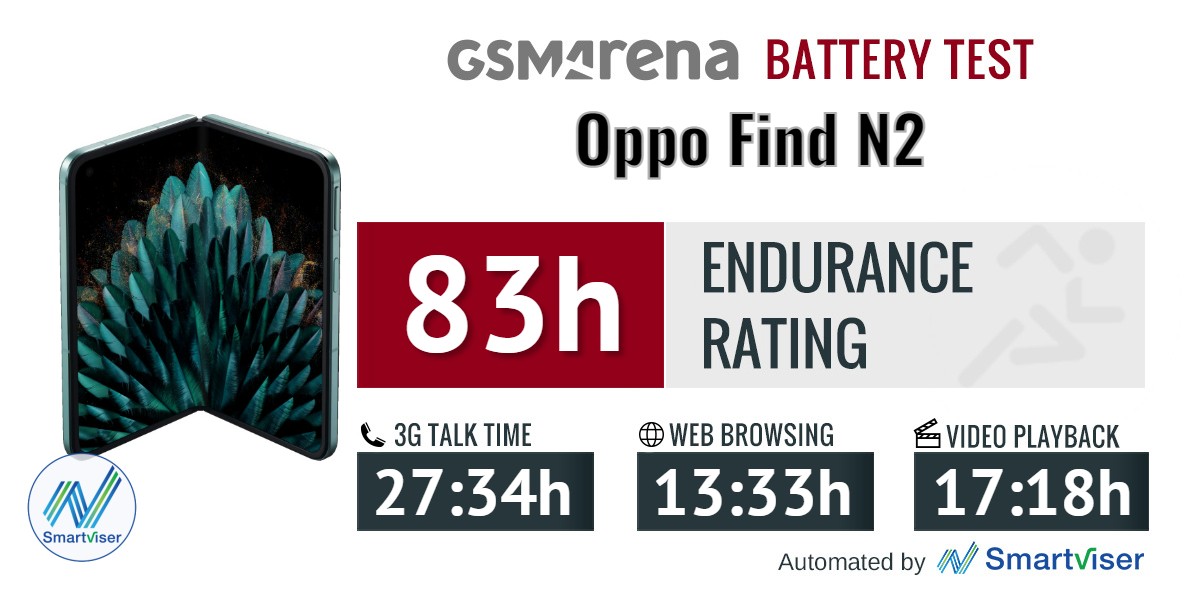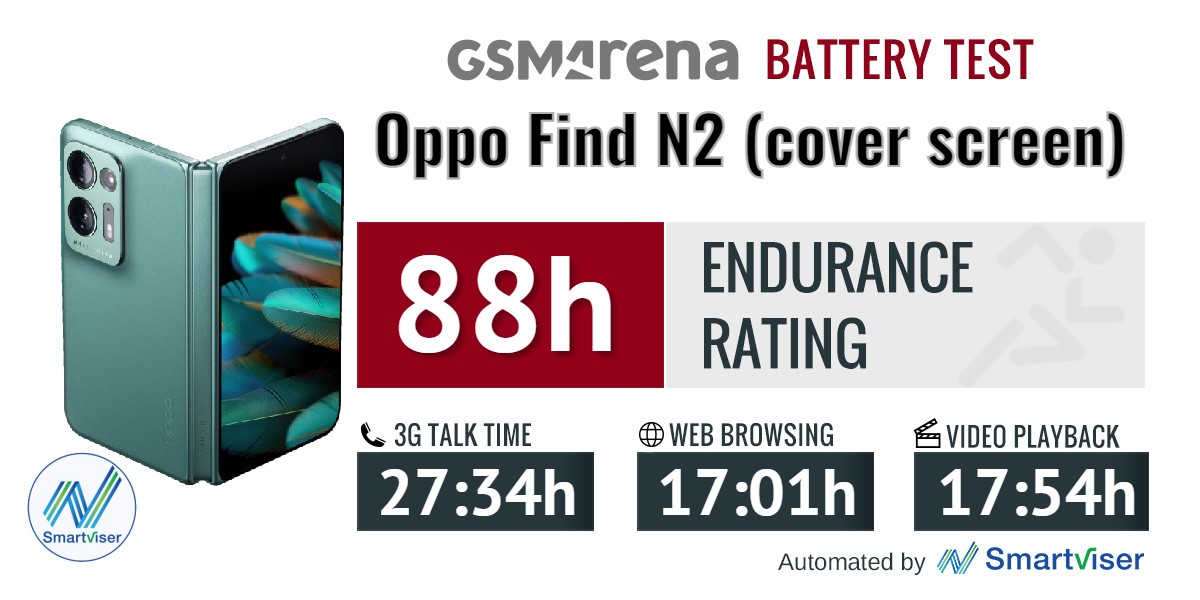Oppo Find N2 review

Brighter 7.1-inch display inside, 5.54 inches on the cover
The Find N2 is hiding a 7.1-inch LTPO AMOLED display inside itself, revealing it all once unfolded. It's quite similarly specced to the one on the previous generation, with the same diagonal and 1,792x1,920px resolution (in a 8.4:9 aspect ratio) making for a 370ppi pixel density. The 120Hz maximum refresh rate remains unchanged too, but Oppo promises increased brightness numbers.

On the cover, you're looking at a 5.54-inch AMOLED with a 1,080x2,120px resolution and an 18:9 aspect ratio. This is a new panel, compared to the Find N's and in addition to the higher resolution and marginally larger diagonal, you're also getting 120Hz refresh rate support - the old one was limited to a rather disappointing 60Hz. This one should be brighter than before too.

Both displays feature a touch sampling rate of up to 480Hz. HDR10+ compliance is also on the specheet (no Dolby Vision, though).
In our brightness testing we measured an impressive 1216nits on the large display when in Adaptive brightness mode and with the phone tablet under bright light. Oppo's numbers are 1550nits for 'outdoor' brightness and 1200nits for HDR purposes, so it could be that our testing software isn't able to trigger the 'correct' mode. In any case, 1216nits is a lot - 200 and change on top of the Galaxy Z Fold4's result. The maximum brightness we got when adjusting the slider manually was 502nits - a more or less standard performance.
| Display test | 100% brightness | ||
| Black, |
White, |
||
| 0 | 502 | ∞ | |
| 0 | 1216 | ∞ | |
| 0 | 490 | ∞ | |
| 0 | 582 | ∞ | |
| 0 | 505 | ∞ | |
| 0 | 809 | ∞ | |
| 0 | 1000 | ∞ | |
| 0 | 522 | ∞ | |
| 0 | 1054 | ∞ | |
| 0 | 506 | ∞ | |
| 0 | 469 | ∞ | |
| 0 | 542 | ∞ | |
| 0 | 494 | ∞ | |
| 0 | 829 | ∞ | |
| 0 | 1266 | ∞ | |
| 0 | 828 | ∞ | |
| 0 | 1760 | ∞ | |
The cover display was 'only' good for 967nits when placed under bright light in Adaptive brightness mode - here the Fold4 does score a marginal victory, mostly good for bragging rights. The Mix Fold 2 is about as bright as the Oppo, while the Huaweis aren't nearly as great. Also the Find N2 is some 200nits brighter than the N(1). The manually attainable 487nits are also par for the course, as was on the internal display.
| Display test | 100% brightness | ||
| Black, |
White, |
||
| 0 | 487 | ∞ | |
| 0 | 967 | ∞ | |
| 0 | 505 | ∞ | |
| 0 | 785 | ∞ | |
| 0 | 486 | ∞ | |
| 0 | 802 | ∞ | |
| 0 | 1034 | ∞ | |
| 0 | 501 | ∞ | |
| 0 | 940 | ∞ | |
| 0 | 514 | ∞ | |
| 0 | 725 | ∞ | |
| 0 | 472 | ∞ | |
| 0 | 601 | ∞ | |
| 0 | 494 | ∞ | |
| 0 | 829 | ∞ | |
| 0 | 1266 | ∞ | |
| 0 | 828 | ∞ | |
| 0 | 1760 | ∞ | |
The Find N2 has a total of 4 color modes, the default being Vivid. It's not the vivid-est one, though - there's also Brilliant, which takes things a step further. Both of these modes are okay-ishly accurate for DCI-P3 targets, but they're notably cold in the whites. The supplementary color temperature slider can correct for that.
There's an easier option, however. The other two modes, Natural and Cinematic, are excellently tuned for sRGB and DCI-P3 content respectively, returning average dE2000 values of around 1 and neutral whites.

The refresh rate menu gives you two options - Standard and High. It's the same setting for both screens, so you can't set it independently on the two. Standard limits things to 60Hz, while High allows the refresh rate to reach the 120Hz maximum. Technically, the internal screen should be able to dynamically adjust the refresh rate all the way down to 1Hz. The cover panel isn't as sophisticated and Oppo doesn't advertise its minimum refresh rate, so we reckon it's a standard 60Hz.
In practice, Android only reports 120Hz and 60Hz modes while the phone is in use with the 'Show refresh rate' utility turned on in Developer options, while the Display.Mode class lists an additional 90Hz mode. There's also the matter that the Android refresh rate reporting ended up being at odds with our tool that reads the fps from the renderer and there were instances where we got 120Hz from android but 60fps from our tool. That's not new, it's another layer of uncertainty when it comes to refresh rate.
In any case, when the Find N2 is in High mode, it will drop its refresh rate after it detects a few seconds of no touch input - likely to 60Hz, but possibly lower - we can't be sure. Video apps will tend to default to 60Hz as soon as you launch them (so no smooth scrolling in YouTube), and there's no high refresh rate for games - a persisting limitation across ColorOS devices.
Oppo Find N2 battery life
The Find N2 is powered by a 4,520mAh battery - an immaterial 20mAh increase in capacity over the previous generation. It's more or less the standard capacity for the segment - the Z Fold4 has a 4,400mAh powerpack, while the Mix Fold 2 and the Mate Xs 2 stand at 4,600mAh.
In our testing, the Find N2 showed improvements in all the 'active' tests, but failed to match the original model's standby efficiency, ultimately leading to a lower overall Endurance rating of 83h.
It's the actual use that matters more, we reckon, and the Find N2's 17:18h result (at a constant 60Hz) is over 3h better than on the Find N(1). The 13:33h on our Wi-Fi web browsing script (at a constant 120Hz) is another increase, to the tune of 15%. Of a similar magnitude is the improvement in voice calls, now at 27:34h.

Our battery tests were automated thanks to SmartViser, using its viSerDevice app. The endurance rating denotes how long the battery charge will last you if you use the device for an hour of telephony, web browsing, and video playback daily. More details can be found here.
The Find N2's results, particularly with the screen on are significantly better than competitors like the Mix Fold 2 or the Mate Xs 2. Even the Galaxy Z Fold4 is trailing in video playback (14:26h), though it does have a minor advantage in web browsing (14:02h).
Video test carried out in 60Hz refresh rate mode whenever possible. Web browsing test done at the display's highest refresh rate whenever possible. Refer to the respective reviews for specifics. To adjust the endurance rating formula to match your own usage - check out our all-time battery test results chart.
Repeating the screen-on tests on the cover display of the Find N2, we got essentially the same results as on the Find N (17:08h and 17:41h).

Charging speed
The Find N2 improves on the N(1)'s 33W charging capability and doubles the rating to 67W. A charger that matches that rating is bundled too.

We clocked a zero to 100% time of 37 minutes on the Find N2 and we were looking at 87% at the half-hour mark (49% in 15 minutes). These aren't record-breaking results in absolute terms, but the Find N2 is just about the fastest-charging large foldable we've tested.
The push for thinness and lower weight has sadly resulted in the Find N2 losing the wireless charging capability that the Find N had. Oh, well.
Speaker test
The Find N2 has a dual speaker setup where both units are on the bottom - same as the previous generation. That does get you a stereo effect when you're using it in tablet mode, but when it's folded the separation is lost. Additionally, the 'opposite' speaker will be playing back the same sound that's meant for the other channel, albeit at a much lower volume.

Both speakers are on the bottom
The Find N2 just managed to inch its way into the 'Good' category for loudness in our test, a notch above the 'Average' Find N, if by just a small margin. The Mate Xs 2 is the only recent large foldable that earned a 'Very Good' rating for loudness.
The Find N2's sound quality is a step up from the Find N, offering slightly livelier treble response and that extra little bit of low-end presence. We'd say it sounds a little better overall than the Galaxy Z Fold4 but not as full as the Mate Xs 2. The Mix Fold 2 is perhaps the least bass-y of the bunch.
Use the Playback controls to listen to the phone sample recordings (best use headphones). We measure the average loudness of the speakers in LUFS. A lower absolute value means a louder sound. A look at the frequency response chart will tell you how far off the ideal "0db" flat line is the reproduction of the bass, treble, and mid frequencies. You can add more phones to compare how they differ. The scores and ratings are not comparable with our older loudspeaker test. Learn more about how we test here.
Reader comments
- Anonymous
- 12 Apr 2024
- nw}
It's it 5g though?
- JH
- 14 Jul 2023
- Mj5
Yes
- NiceSimplicity
- 01 Jun 2023
- NIe
Honestly, the battery life is really good on this device. especially if you use a good balance of the front cover display. But keep in mind I only really unfold my phone for media consumption and multitasking. I do really miss the removable storage t...